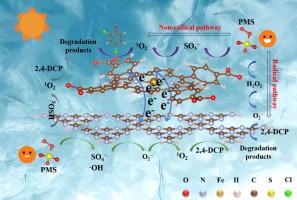Self-assembled metalloporphyrin-carbon nitride heterointerface promotes fenton-like activity to purify high-salinity phenolic wastewater
IF 8.1
1区 工程技术
Q1 ENGINEERING, CHEMICAL
引用次数: 0
Abstract
Developing a Fenton-like peroxymonosulfate (PMS) activator capable of producing 1O2 is beneficial for treating high-salinity wastewater. Herein, the FeTCPP-CN catalyst was synthesized by self-assembling iron (Ⅲ) tetrakis(4-carboxyphenyl)porphyrin (FeTCPP) molecule with lamellar carbon nitride (CN) polymer. The formed hydrophilic-hydrophobic heterointerface enhanced the adsorption potential with pollutants, and the hydrogen bonding and π-π interactions between interfaces constructed an efficient electron transfer channel, while the highly dispersed Fe-N4 moiety promoted atomic utilization efficiency. In the FeTCPP-CN/PMS system, 2,4-dichlorophenol (2,4-DCP) could be efficiently degraded under high concentration (200 mM) of inorganic salts, and the excellent degradation performance could be maintained over 10 cycles in a continuous flow device. During the reaction, the O2·- and 1O2 were identified as the main active species, where *SO5·- was the crucial intermediate to selectively generate 1O2. This work offers insights into the construction of efficient catalysts for the treatment of high-salinity phenolic wastewater.

自组装金属卟啉-氮化碳异质界面促进类fenton活性净化高盐度酚类废水
开发一种能产生1O2的类fenton型过氧单硫酸盐(PMS)活化剂有利于处理高盐度废水。本文以铁(Ⅲ)四akis(4-羧基苯基)卟啉(FeTCPP)分子与层状氮化碳(CN)聚合物自组装为原料,合成了FeTCPP-CN催化剂。形成的亲疏水异质界面增强了对污染物的吸附潜力,界面之间的氢键和π-π相互作用构建了高效的电子传递通道,而高度分散的Fe-N4片段提高了原子利用效率。在FeTCPP-CN/PMS体系中,2,4-二氯苯酚(2,4- dcp)在高浓度(200 mM)无机盐条件下可有效降解,并且在连续流装置中可保持10个循环以上的优异降解性能。在反应过程中,O2·-和1O2是主要的活性物质,其中*SO5·-是选择性生成1O2的关键中间体。这项工作为高盐度酚类废水处理的高效催化剂的构建提供了见解。
本文章由计算机程序翻译,如有差异,请以英文原文为准。
求助全文
约1分钟内获得全文
求助全文
来源期刊

Separation and Purification Technology
工程技术-工程:化工
CiteScore
14.00
自引率
12.80%
发文量
2347
审稿时长
43 days
期刊介绍:
Separation and Purification Technology is a premier journal committed to sharing innovative methods for separation and purification in chemical and environmental engineering, encompassing both homogeneous solutions and heterogeneous mixtures. Our scope includes the separation and/or purification of liquids, vapors, and gases, as well as carbon capture and separation techniques. However, it's important to note that methods solely intended for analytical purposes are not within the scope of the journal. Additionally, disciplines such as soil science, polymer science, and metallurgy fall outside the purview of Separation and Purification Technology. Join us in advancing the field of separation and purification methods for sustainable solutions in chemical and environmental engineering.
 求助内容:
求助内容: 应助结果提醒方式:
应助结果提醒方式:


